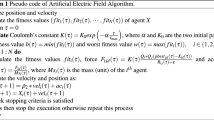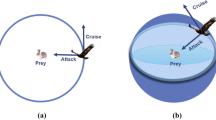Abstract
The Artificial Electric Field Algorithm (AEFA) is a population-based stochastic optimization algorithm for solving continuous and discrete optimization problems, and it is based on Coulomb’s law of electrostatic force and Newton’s laws of motion. Over the years, AEFA has been used to solve many challenging optimization problems. In this article, AEFA is used to solve 100 digit challenge benchmark problems, and the experimental results of AEFA are compared with recently proposed algorithms such as dragonfly algorithm (DA), whale optimization algorithm (WOA), the salp swarm optimization (SSA), and fitness dependent optimizer (FDO). The performance of AEFA is found to be very competitive and satisfactory in comparison with other optimization algorithms chosen in the article.
Access this chapter
Tax calculation will be finalised at checkout
Purchases are for personal use only
Similar content being viewed by others
References
Angeline PJ (1998) Using selection to improve particle swarm optimization. In: 1998 IEEE International conference on evolutionary computation proceedings. IEEE World Congress on Computational Intelligence (Cat. No. 98TH8360). IEEE, pp 84–89
Yadav A et al (2019) AEFA: artificial electric field algorithm for global optimization. Swarm Evol Comput 48:93–108
Storn R, Price K (1997) Differential evolution—A simple and efficient heuristic for global optimization over continuous spaces. J Glob Optim 11(4):341–359
Kennedy J, Eberhart R (1995) Particle swarm optimization. In: Proceedings of ICNN’95-International Conference on Neural Networks, vol 4. IEEE, pp 1942–1948
Karaboga D (2010) Artificial bee colony algorithm. Scholarpedia 5(3):6915
Huang C-L, Huang W-C, Chang H-Y, Yeh Y-C, Tsai C-Y (2013) Hybridization strategies for continuous ant colony optimization and particle swarm optimization applied to data clustering. Appl Soft Comput 13(9):3864–3872
Dorigo M, Gambardella LM (1997) Ant colony system: a cooperative learning approach to the traveling salesman problem. IEEE Trans Evol Comput 1(1):53–66
Venkata Rao R (2016) Teaching-learning-based optimization algorithm. In: Teaching learning based optimization algorithm. Springer, pp 9–39
Yadav A, Deep K, Kim JH, Nagar AK (2016) Gravitational swarm optimizer for global optimization. Swarm Evol Comput 31:64–89
Abdullah JM, Ahmed T (2019) Fitness dependent optimizer: inspired by the bee swarming reproductive process. IEEE Access 7:43473–43486
Mirjalili Seyedali (2016) Dragonfly algorithm: a new meta-heuristic optimization technique for solving single-objective, discrete, and multi-objective problems. Neural Comput Appl 27(4):1053–1073
Mirjalili S, Lewis A (2016) The whale optimization algorithm. Adv Eng Softw 95:51–67
Mirjalii SZ, Saremia C, Farisd H, Mirjalilia S, Gandomibf AH, Mirjalilie SM (2017) Salp swarm algorithm: a bio-inspired optimizer for engineering design problems. 114:163–191
Yadav Anupam, Kumar Nitin et al (2020) Artificial electric field algorithm for engineering optimization problems. Expert Systems Appl 149:113308
Ali MZ, Sunganthan PN, Price KV, Awad NH. The 2019 100-digit challenge om real-parameter, single objective optimization: analysis of results
Author information
Authors and Affiliations
Editor information
Editors and Affiliations
Rights and permissions
Copyright information
© 2022 The Author(s), under exclusive license to Springer Nature Singapore Pte Ltd.
About this paper
Cite this paper
Chauhan, D., Yadav, A. (2022). Performance of Artificial Electric Field Algorithm on 100 Digit Challenge Benchmark Problems (CEC-2019). In: Gupta, G., Wang, L., Yadav, A., Rana, P., Wang, Z. (eds) Proceedings of Academia-Industry Consortium for Data Science. Advances in Intelligent Systems and Computing, vol 1411. Springer, Singapore. https://doi.org/10.1007/978-981-16-6887-6_31
Download citation
DOI: https://doi.org/10.1007/978-981-16-6887-6_31
Published:
Publisher Name: Springer, Singapore
Print ISBN: 978-981-16-6886-9
Online ISBN: 978-981-16-6887-6
eBook Packages: Intelligent Technologies and RoboticsIntelligent Technologies and Robotics (R0)




